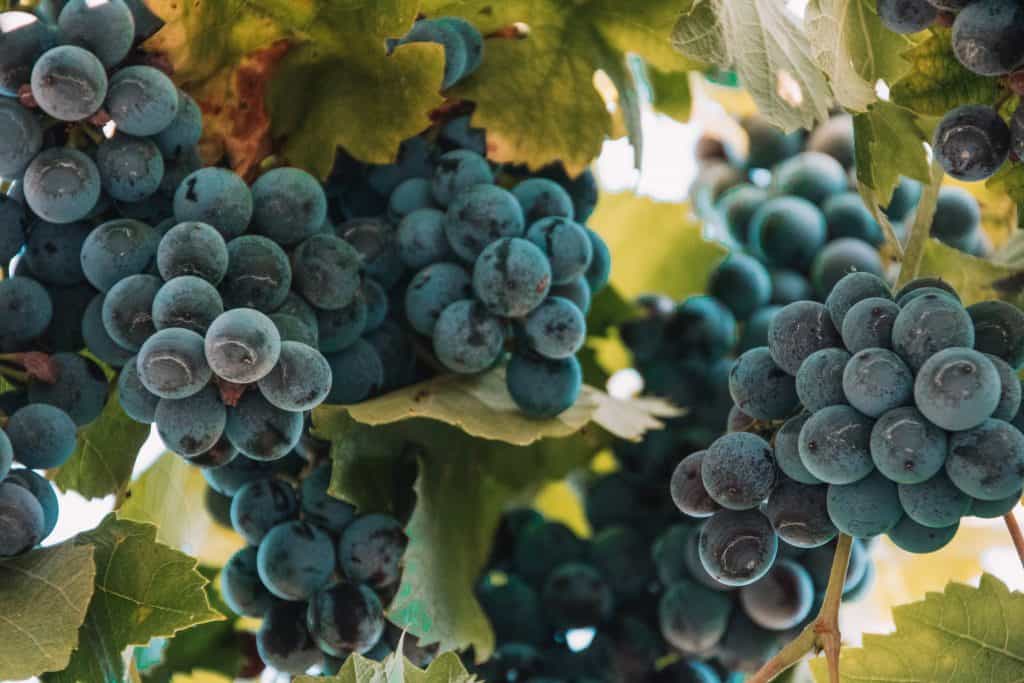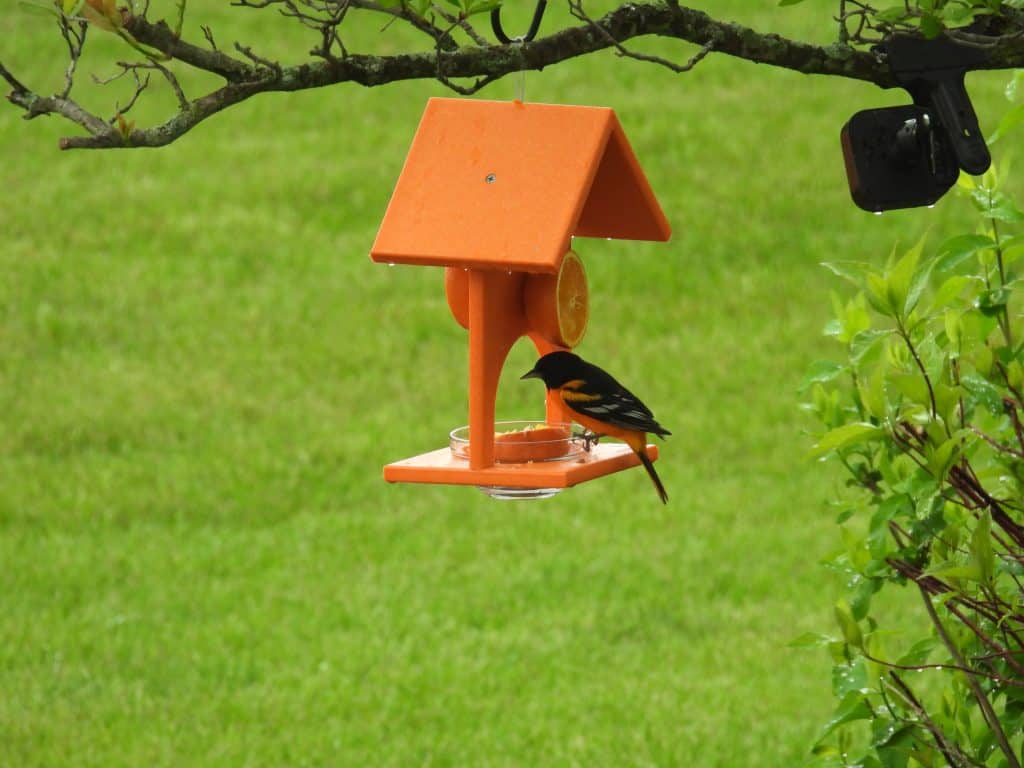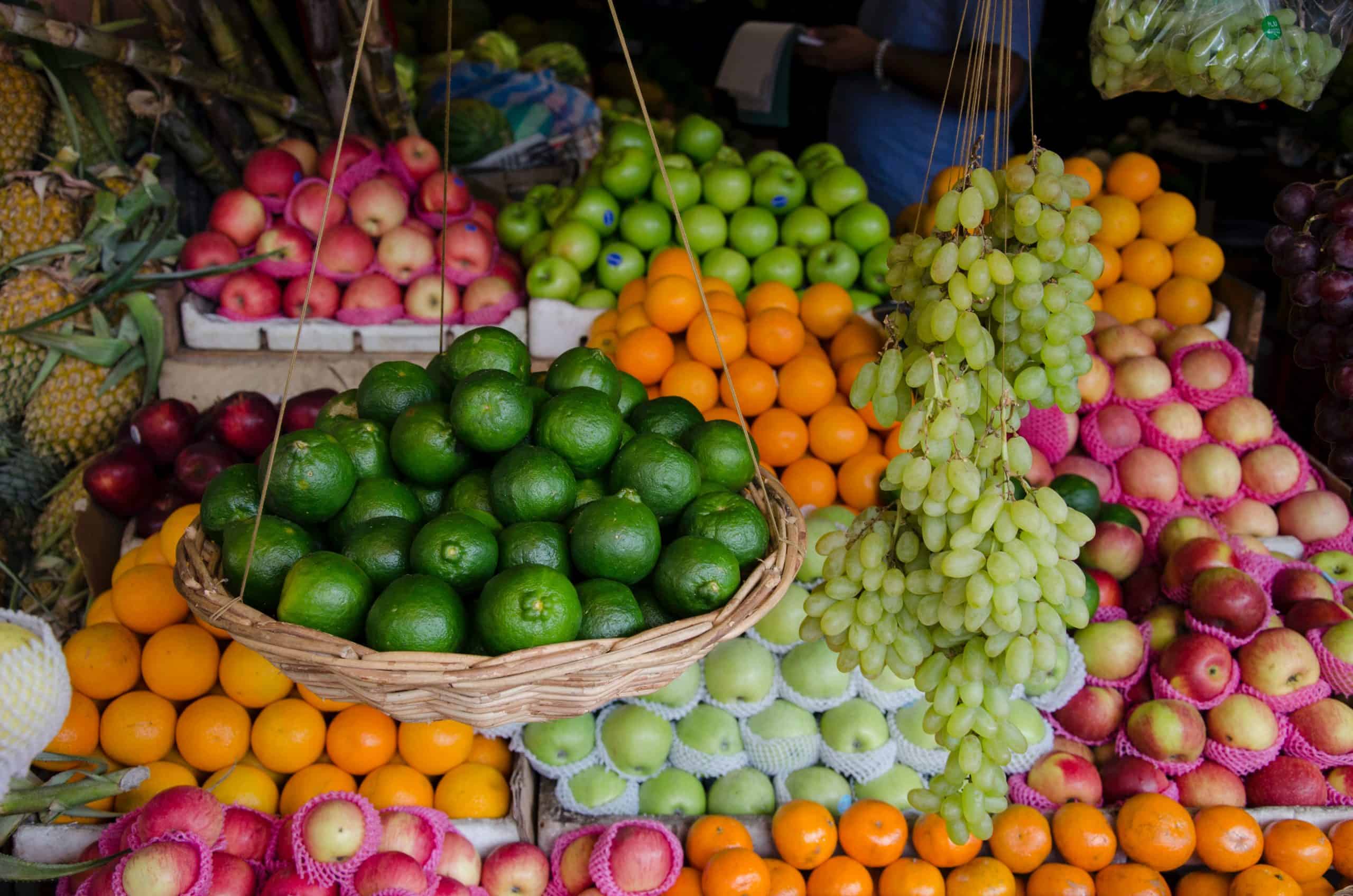Birds will eat many types of fruit. Of course, they love oranges but what about grapes, bananas, or cranberries? This article reveals all the fruits birds love, and which species you’ll attract. Get ready to become your feathered friends’ favorite yard in the neighborhood.
Fruit is a natural part of many birds’ diets across the world. If you don’t have wild bird seed or don’t wish to hang a feeder, you may be wondering if fruit could work as a substitute for attracting backyard birds.
The answer is yes! There are many types of fruits birds will eat, but different species are more likely to pick varying fruits, depending on their diet. Fruit type, ease of eating, and freshness all play a part.
Let’s survey grapes, apples, oranges, bananas, blueberries, pears, and raisins, detailing everything you need to know about feeding each fruit to birds.
Do Birds Eat Grapes?
Yes, grapes are a type of fruit birds will eat. In fact, oranges are beloved by orioles, Steller’s jays, American robins, and many other backyard birds.
However, not all birds like grapes. A bird’s beak shape is a reliable indicator of its feeding preferences. The three species mentioned above have long, slender beaks capable of picking up grapes. Birds with beaks for eating seeds, nuts, or insects may not prefer grapes.
In addition, a bird’s stomach regulates its diet. Many birds lack stomachs that allow high-fruit diets.

Grapes may seem like a big mouthful for birds, but they aren’t difficult to swallow! Birds have no trouble with grape skin, and it is a great source of fiber and nutrition for them.
Still, it’s always best to offer washed, seedless grapes in your feeders to prevent incidents. If you’re worried about birds choking, try serving them chopped halves.
Can Grapes Attract Birds to My Feeders?
Grapes are perfect for attracting birds, especially in winter. When the ground hardens from ice and snow, many birds cannot forage for worms and insects beneath the soil. During that time, they look for fruits, tree seeds, and nuts that are available above the surface.
Feeder competitors like squirrels, chipmunks, and raccoons are less active during the cold seasons. Pests are also inactive, so you don’t need to worry about ants or gnats accumulating on the fruit.
Regardless of the season, setting out whole grapes or halves in feeders will attract many birds. Red-winged blackbirds, mockingbirds, and cardinals are common examples. You can put the grapes inside a feeder or place them on a flat surface like a table to lure the birds.
What Types of Grapes Suit Birds Best?
Birds of all kinds aren’t particularly picky, making it an easy task to find grapes to feed them. They love green, red, and purple varieties. Fresh or frozen fruit makes little difference to birds since grapes are a wintertime favorite for many of them. You’re free to remove the seeds.
Any vineyard farmer will tell you that the birds are happy to pluck from the vine, too! If you’re running a trellis or garden at home, birds may sample your crop. Placing some grapes in a secure feeder will divert their attention from your vineyard.
Do Birds Eat Apples?
Yes, apples are a type of fruit birds will eat. Birds like the varied thrush and American robin even eat wild crabapples, which most humans wouldn’t dare consume. These fibrous fruits grow between late summer and early autumn, making them a favorite for migrating birds.
Many birds like cedar waxwings are even attracted to the blossoms on apple trees, eating the foliage, petals, and nectar inside. However, anything bigger than a crab apple takes a while to eat. Birds tend to carve out a spot with their beaks to peck away at the mealy inner apple.
Can Apples Attract Birds to My Feeder?
Birds will love apples at your bird feeder! However, you will need to chunk the fruit to appeal to most of them, since some won’t be as interested in large fruits. Cut the apples into small pieces for your feeder to prevent choking.
Don’t worry about apple seeds! Many believe that they are toxic to wild and domesticated birds. While apple seeds do contain cyanide, it is not enough to cause any harm to your flock. If you’re still worried about it, feel free to remove the seeds.
The fibrous apple skin is nutritious for birds, and they won’t show much interest in the core or stems. However, apples might bring a lot more than birds to your feeder. Check your feeder often to ward away pests and make sure the fruit is in a safe place for your feathered friends.
What Types of Apples Suit Birds Best?
Birds love all kinds of apples, even ones that people consider inedible. They’ll even dig into apples on trees in your yard. There are three ways to serve apples at your feeder:
- Leave the whole apple on a flat surface near your feeder. Birds will peck through the skin and enjoy the inside!
- Cut the apple into halves and lay them on a flat surface with the flesh face up. Birds will land on the fruit and carve it out happily.
- Cut the apple into small chunks in a birdfeeder. Make sure the pieces are at least as small as grapes so that there is no choking hazard.
Do Birds Eat Oranges?
Oranges are another type of fruit birds will eat. This juicy citrus fruit is a nutritious favorite for orioles, bluebirds, bluebirds, catbirds, grosbeaks, mockingbirds, robins, tanagers, towhees, waxwings, and for attracting woodpeckers. They’re also great for attracting sapsuckers!
Below is a short clip from my backyard.
Birds don’t care whether they are mandarin oranges, tangerines, or other types. Citrus fruits are easy to prepare and don’t pose a choking hazard.
Oranges are an excellent source of vitamin C for birds, too. The fruit also helps to supplement their intake of potassium and vitamin A. Orange seeds do contain trace amounts of cyanide, but much like with apples, it isn’t enough to be harmful.
Backyard birds can eat orange peels, but many prefer not to. They have a hard texture and taste too bitter for most browsing creatures. That’s why I don’t recommend leaving whole oranges for birds to enjoy.
If you’re preparing oranges for avian enjoyment, providing them as halves is the best way. Tanagers, orioles, and other species will drop by to peck out some of the juicy flesh.
Would you believe even hummingbirds love a sip of fresh orange juice? Check out the video below I captured in my backyard.
Before long, there won’t be much citrus left! However, in the summertime, be careful of unwanted pests. Ants and other bugs will eat orange peels and may deter birds from enjoying the fruit.
Can Oranges Attract Birds to My Feeder?
Oranges will attract birds to your feeder! There are even specially-designed orange feeders for orioles and other birds on the market. Let’s talk about how to prepare citrus fruits for your feeding station.

The Songbird Essentials Oriole feeder is very popular in my yard.
First, slice the fruit in halves. Doing so makes it more attractive to birds and keeps the fruit face-up and easy for them to eat. Clean it thoroughly and remove the seeds if you choose. They are neither harmful nor a choking hazard for birds.
Once the halves are ready, place one per feeder, feeding table, or flat surface with the fleshy side up. If you want to attract woodpeckers and sapsuckers, place the orange halves in trees. You’ll want to put them where branches hold up the fruit so that it doesn’t fall on the ground. Birds will eat oranges off the ground, but not if they are overrun by ants or other bugs.
Before long, plenty of feathered friends will be flocking to your feeders. When they start to slow down, swap out the remains for fresh orange halves and they’re bound to make a return trip!
Do Birds Eat Bananas?
Yes, bananas are a type of fruit birds will eat. Bananas will attract bluebirds, eastern starlings, robins, and other thrushes. Birds that live in tropical climates like some tanager species and parrots eat them as part of their natural diet. Since bananas grow all year, they’re always in supply for bird feeders.
These fruits are an excellent source of potassium.
Can Bananas Attract Birds to My Feeders?
Bananas can attract birds to your feeder. However, you should serve them in moderation. They are starchy, filling fruits, so birds often only eat a little at a time. I suggest mashing bananas for feeders and leaving out the peels. A banana’s thick peel contains cellulose, a plant part that birds can’t digest.
Thankfully, fresh bananas are so mushy that they’re never a choking hazard for birds. You can feed them frozen banana chunks, but make sure to defrost them and cut them into grape-sized pieces for easy swallowing.
Otherwise, you can remove the whole fruit from the peel and place it on a flat surface or feeding table in a safe area.
Do Birds Eat Blueberries?
Yes, blueberries are a type of fruit birds will eat. Several species of birds, such as waxwings, have diets consisting mainly of small berries. They love cherries and blueberries! You’ll find breathtaking bluebirds, robins, and others delighted by these sweet, nutritious, easily-digestible treats.
Blueberries are safe and risk-free due to their small size. Furthermore, they will fit in any feeder or bowl that birds frequent.
Natural blueberry bushes are a favorite of many bird species. You’ll notice that most feathered creatures won’t eat where they don’t feel safe. Blueberry bushes offer plenty of shelter in addition to delectable fruits.
Can Blueberries Attract Birds to My Feeders?
Blueberries will attract many birds. They’ll eat fresh and defrosted frozen blueberries. They’re small and easy to fit in hanging feeders, bowls, or feeding tables. Like grapes, blueberries are full of antioxidants that keep birds healthy and reduce the stress of migration.
Do Birds Eat Pears?
Yes, pears are a type of fruit birds will eat. In fact, pears are another favorite for thrushes (such as robins and bluebirds), jays, and crows. Pears are similar to apples in many ways. These fruits are available in the middle of autumn, so you can find many birds feasting on them during migration.
Backyard birds enjoy pears from trees and feeders. Like with apples, they tend to hollow out a place to eat the mealy nutrients inside. You never have to worry about birds choking on pears since they won’t try to swallow them whole.
However, like apple seeds, pear seeds contain cyanide. It shouldn’t be enough cyanide to harm your birds, but you can remove the seeds if it worries you.
In general, pears are less popular fruits for feeders since few birds eat them naturally. Still, you can attract many kinds of blackbirds, bluebirds, and robins.
Can Pears Attract Birds to My Feeders?
Offering pears will attract many different backyard birds. They’ll stop by to peck through a whole pear, but it is easier to offer pear halves or pieces. Remove the seeds and place the pear halves on a feeding table or flat surface near your birdfeeder.
If you cut the fruit into small chunks, it will fit easily in any hanging dish-style feeder. Removing the skin of the pear is up to you. It may make the fruit easier to eat, but it also contains vital antioxidants that promote avian health.
Fresh or frozen pears work well once you defrost them. Many flying friends even enjoy jellies, jams, and preserves made of pears.
Do Birds Eat Raisins?
Yes, raisins are a type of fruit birds will eat. Many of the same species like waxwings, bluebirds, blackbirds, and mockingbirds love raisins. Like grapes, they are small and easy to eat, posing no choking hazard. Raisins don’t grow naturally on the vine, but most avian species who frequent grapevines will show interest in these dried treats.
Raisins are a favorite of birds who like to grab and go since they’re light and easy to carry. It may cause them to not linger at your feeder since most birds prefer eating somewhere safe or concealed.
Raisins are full of health benefits like better digestion and reduced inflammation.
Can Raisins Attract Birds to My Feeders?
Raisins will attract birds to your feeders, however, it’s best to let them soak overnight. Place the rehydrated treats on a feeding table or in a dish for birds to enjoy. Many birdseed blends include dried fruit like raisins as part of the mix, too.
Which Species of Birds Eat Fruit?
Most fruit-eating birds are thrushes. This group includes bluebirds, robins, mockingbirds, and waxwings. Orioles and tanagers also love citrus so you can attract them with orange halves. As I mentioned earlier, even hummingbirds will partake in a sip of fresh orange juice.
Most other backyard bird species prefer seeds, insects, or nectar, but a hungry creature will still take any fruit you offer.
Frugivorous: feeding on fruit
Merriam-Webster
Below, I’ve made a table of common frugivorous birds and their primary fruits of choice. Use it to pick the best feeder meals for your area and climate!
| Grapes | Apples | Bananas | Blueberries | Pears | Raisins | Oranges | |
| Orioles | ✓ | ✓ | |||||
| Tanagers | ✓ | ✓ | |||||
| Bluebirds | ✓ | ✓ | ✓ | ✓ | ✓ | ||
| Jays/Mockingbirds | ✓ | ✓ | ✓ | ✓ | ✓ | ||
| Robins | ✓ | ✓ | ✓ | ✓ | ✓ | ✓ | |
| Hummingbirds | ✓ | ||||||
| Waxwings | ✓ | ✓ | ✓ | ✓ | |||
| Blackbirds | ✓ | ✓ | ✓ | ||||
| Sapsuckers/Woodpeckers | ✓ | ✓ |
Do Birds Eat Fruit in Every Season?
Birds that love fruit will eat it any time of year, but you will notice a spike during the winter. When the soil hardens from frost, many thrushes lose sustainable access to worms and other insects, so fruit becomes a large part of their diet. In winter, birds will eat apples and even oranges, especially because their bright colors are easy to see from above.
Check out the female Baltimore oriole below enjoying a fresh orange half in my backyard.
Depending on where you live, you might see plenty of birds stopping by during migration season, which begins in late summer and ends in late autumn. Birds that live in slightly colder areas may fly south to your location to enjoy a healthy treat.
How Does a Bird’s Digestive System Handle Fruit?
The avian digestive system can handle most fruits, but not ones with too many seeds like pomegranate. However, most frugivore stomachs have special adaptations for their preferred diet. Many birds experience intestinal changes with the seasons, as their stomachs get ready to accommodate fruit in the late fall and winter.
Some birds like the yellow-rumped warbler cannot subsist on starchy foods like pears. All in all, each bird’s digestive system depends on its diet, and most fruit-loving birds have adapted to handle eating these nutritious treats all winter long.
Conclusion
Certain species of birds are very fond of fruit. If you prepare it well, they won’t hesitate to transform a dull feeder into a lively hub. Remember to always use fresh fruit and remove peels, pits, or other indigestible parts. Frozen treats are fine as long as they’re defrosted, ripe, and ready to eat!
Birds enjoy feeders the most if they feel safe. Be sure to shelter them and place your feeding stations near hiding places like bushes and trees. A birdbath may also be an alluring commodity for avian visitors that can draw them to eat the fruit you provide.
As long as they feel secure, birds of all colors in all seasons will be overjoyed to land and eat your healthy treats!









